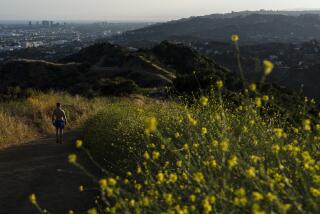The Seed of a Bright Idea
- Share via
Mustard is one of man’s oldest cultivated seasonings, ranking second only to black pepper as the world’s most popular spice. Records of its use go back to at least 4000 BC. In prehistoric times, it’s believed that wild mustard seeds were chewed right along with meat.
Mustard seeds were found in Egypt’s great pyramids. Romans took mustard seed with them to Gaul, which later became France, where mustard has become an integral ingredient in many dishes, especially those of Burgundy and its capital, Dijon.
Thomas Jefferson is known to have appreciated and grown mustard at Monticello after experiencing it in France.
Mustard spread throughout Europe into England, where Colman’s brand dry mustard powder became, and still is, a staple of English cooking. Mustard probably came to America with the Spanish explorers and certainly was cultivated by the Spanish fathers who founded the mission system in California. In the spring, mustard plants, with their bright yellow flowers, are a reminder of those missionaries, for whom the mustard seed was a sign of faith.
The seeds, of course, aren’t the only edible part of the plant. Mustard leaves or greens are excellent in salads (when young) or sauteed or braised when older and larger. They are a key component in Southern cooking, and many varieties of leafy mustard are used in Asian cuisines.
Mustard also acts as an important tool in organic farming to fight harmful insects. Planted in proximity to many fruits and vegetables, it attracts insects to it and away from other crops.
Mustard is also a powerful preservative and works effectively against the growth of a whole host of microorganisms.
Probably one of mustard’s greatest contributions to health is that it provides tons of flavor with very few calories or fat and can be used to “pump up” flavor in otherwise bland or boring low-fat foods.
BASIC HOME-STYLE MUSTARD
3 tablespoons yellow mustard seeds
3 tablespoons brown mustard seeds
1/3 cup brown or yellow mustard powder
1/3 cup cold water
3 tablespoons white wine vinegar
2 tablespoons brown sugar
1 teaspoon salt
The most basic of mustards is simply a mixture of mustard powder and water. This recipe has a little more going for it. Remember that most homemade mustards tend to be a bit more runny and more pungent than commercially made, but that’s their charm. Also, homemade mustard needs to mature at least a day, and preferably longer, before being used. When it’s first made, the flavor will be almost unpleasant.
Coarsely grind yellow and brown mustard seeds in spice grinder or coffee mill. Mix together with mustard powder and water. Allow mixture to stand at least 1 hour. Stir in vinegar, brown sugar and salt. Cover and refrigerate at least 1 day before using.
1 cup. Each tablespoon:
41 calories; 148 mg sodium; 0 cholesterol; 2 grams fat; 4 grams carbohydrates; 2 grams protein; 0.50 gram fiber.
MANGO-MUSTARD SEED SAUCE
2 tablespoons yellow or black mustard seeds
1 cup fresh mango puree (from 2 ripe mangoes)
2 teaspoons finely minced ginger
1 teaspoon finely minced garlic
1/2 teaspoon fragrant curry powder
1/2 cup fresh grapefruit juice
2 teaspoons Sherry vinegar
1 1/2 teaspoons chile-sesame oil
1/3 cup chopped ripe fresh banana, optional
1 teaspoon honey or to taste
Salt
Freshly ground white pepper
This is a delicious fresh sauce that is great with grilled white meats or fish. It can also be thinned with additional juice or stock to be used as a dressing for savory salad greens, including arugula, mustard or mizuna.
Place mustard seeds in small skillet over medium heat and toast until they just begin to pop. Immediately cover and remove from heat. Let cool.
Briefly process mustard seeds, mango puree, ginger, garlic, curry powder, grapefruit juice, vinegar, chile-sesame oil, banana, honey and salt and pepper to taste in blender or food processor to produce smooth sauce. Cover and refrigerate up to 3 days.
2 cups. Each tablespoon:
11 calories; 9 mg sodium; 0 cholesterol; 0 fat; 2 grams carbohydrates; 0 protein; 0.10 gram fiber.
WARM SALAD OF MUSTARD GREENS, STILTON AND PANCETTA
1/4 cup olive oil
1 tablespoon whole yellow mustard seeds
1/2 cup minced onion
2 teaspoons minced garlic
1/4 cup white balsamic vinegar
1/2 cup peeled and diced tart sweet apple, such as Gala
Salt
Freshly ground pepper
1 pound young tender mustard greens, tough stems removed
1/4 pound pancetta, thinly sliced and lightly browned
3 ounces Stilton cheese, crumbled
Place oil and mustard seeds in nonstick skillet and cook over moderate heat until mustard seeds begin to pop (cover if necessary). Add onion and garlic and cook until soft but not brown. Stir in vinegar and apple and season to taste with salt and pepper.
Pour over mustard greens. Toss with pancetta and cheese. Serve immediately.
4 servings. Each serving:
308 calories; 759 mg sodium; 31 mg cholesterol; 23 grams fat; 14 grams carbohydrates; 13 grams protein; 1.50 grams fiber.
More to Read
Eat your way across L.A.
Get our weekly Tasting Notes newsletter for reviews, news and more.
You may occasionally receive promotional content from the Los Angeles Times.










